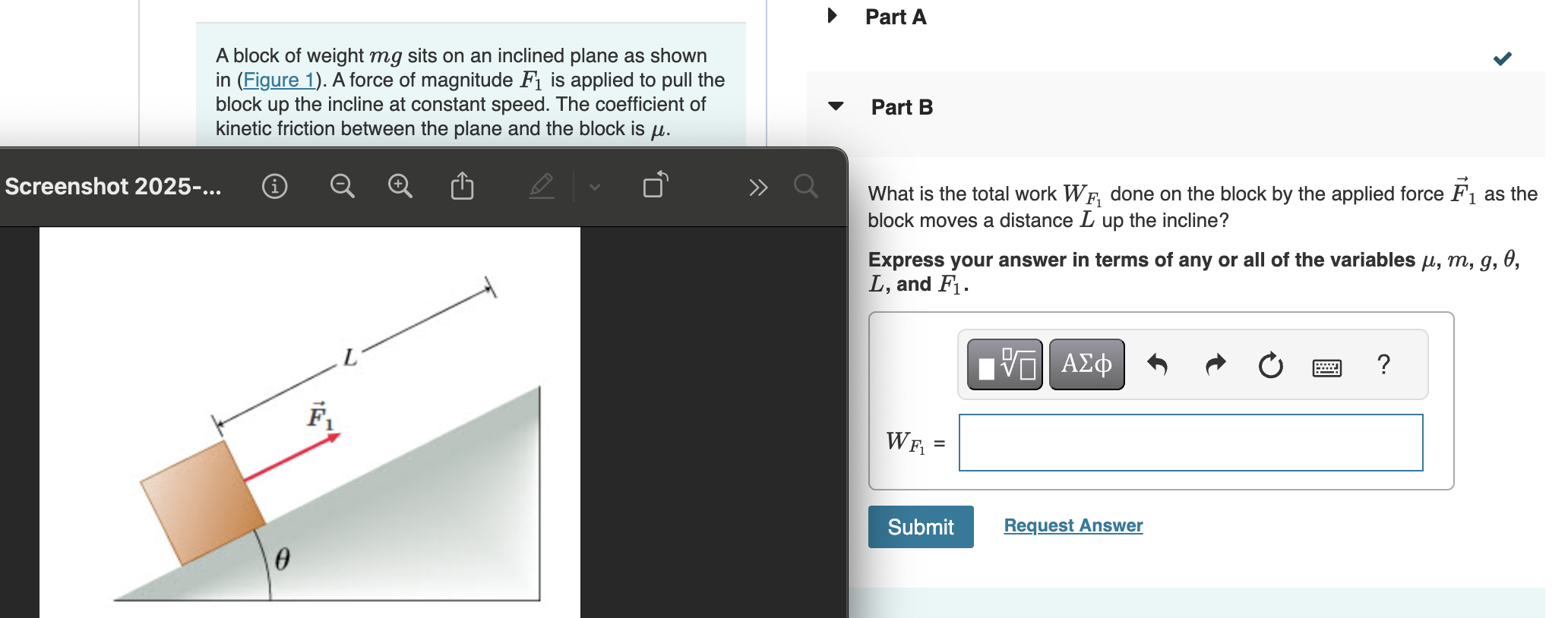What is the total work done on the block by the applied force as the block moves a distance up the incline? Express your answer in terms of any or all of the variables μ, m, g, L,... What is the total work done on the block by the applied force as the block moves a distance up the incline? Express your answer in terms of any or all of the variables μ, m, g, L, and F1.

Understand the Problem
The question is asking for the total work done by the applied force on a block as it moves up an inclined plane. The work needs to be expressed in terms of certain variables: the coefficient of kinetic friction ( ), mass of the block ( ), gravitational acceleration ( ), the length the block moves ( ), and the applied force ( ).
Answer
$$ W_{F_1} = \left( mg \sin(\theta) + \mu (mg \cos(\theta)) \right) L $$
Answer for screen readers
$$ W_{F_1} = \left( mg \sin(\theta) + \mu (mg \cos(\theta)) \right) L $$
Steps to Solve
- Identify Forces Acting on the Block The forces acting on the block include:
- The gravitational force ($F_g = mg$) acting downwards.
- The normal force ($F_N$) acting perpendicular to the incline.
- The frictional force ($F_f = \mu F_N$) acting down the incline.
- The applied force ($F_1$) acting up the incline.
-
Calculate the Normal Force The normal force can be found using the weight of the block and the angle of the incline: $$ F_N = mg \cos(\theta) $$
-
Calculate the Frictional Force Now, substitute the normal force into the frictional force equation: $$ F_f = \mu F_N = \mu (mg \cos(\theta)) $$
-
Apply Newton's Second Law Since the block is moving up the incline at constant speed, the net force along the incline is zero: $$ F_1 - F_f - F_g \sin(\theta) = 0 $$ Substituting the expressions for the forces: $$ F_1 - \mu (mg \cos(\theta)) - mg \sin(\theta) = 0 $$
-
Solve for the Applied Force $F_1$ Rearranging the equation gives: $$ F_1 = mg \sin(\theta) + \mu (mg \cos(\theta)) $$
-
Calculate the Work Done by the Applied Force Work done by the applied force as the block moves a distance $L$ is: $$ W_{F_1} = F_1 \cdot L $$ Now substitute $F_1$ from the previous step into this equation: $$ W_{F_1} = \left( mg \sin(\theta) + \mu (mg \cos(\theta)) \right) L $$
$$ W_{F_1} = \left( mg \sin(\theta) + \mu (mg \cos(\theta)) \right) L $$
More Information
The work done by the applied force represents the energy transferred to the block as it moves up the incline, overcoming both gravitational force and friction.
Tips
- Forgetting to consider the direction of forces; forces acting against the direction of motion should reduce the net work done.
- Not correctly substituting the angles in trigonometric functions while calculating forces on inclined planes.
AI-generated content may contain errors. Please verify critical information